Kaskazi Marlin

Length 15' 7" (4.75 m), Width 24.5" (62 cm), Weight 55 lbs (25 kg).
Maximum weight capacity 352 lbs (160 kg) depending on water conditions.
After spending two wet nights under canvas it was wonderful to wake to the sun warming the sides of my tent, it was a sunny Sunday morning in Guernsey. I'd been invited over, along with a small group of kayak fishermen from the mainland to promote kayak fishing; we were the guests of the nice people at Outdoor Guernsey and Condor Ferries.
Saturday had been hugely successful, Outdoor Guernsey had organised a demo day at Cobo Bay, although the weather had taken a turn for the worse the Guernsey locals turned out in force and many took to the water to try out the various demonstration kayaks, amongst them was the kaskazi Marlin.
Simon from KaskaziUK had brought over the Kaskazi Dorado and the new Marlin to make up part of the Demo fleet. Having loved the Pelican when I reviewed it last year I was keen to paddle the new Marlin, paddling it in the beautiful waters around Guernsey with its huge tidal range and constantly changing scenery was an added bonus.
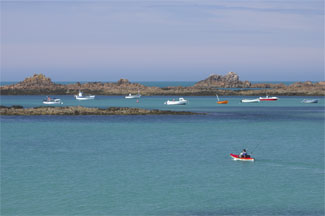
Guernsey has some beautiful scenery.
The Kaskazi Marlin is the angling version of the Kaskazi Pelican available in a choice of constructions, full carbon, epoxy fibreglass or fibreglass sandwich, our test model was produced in fibreglass sandwich, which weighs in at an amazing 25kg including accessories, the other two layups are even lighter and stronger and of course, more expensive.
Kaskazi ensure that they match their brochure weights by carefully weighing the building materials during each stage of the building process, each kayak is hand built by a highly skilled team in South Africa.
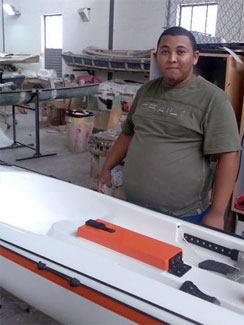
The Marlin is hand built.
Dropping into the Marlin's deep, comfortable cockpit I realised that the foot pedals required adjusting before paddling away, an easy job, even out on the water. The pedals adjust by simply pulling out a sprung loaded knob and setting it in a different hole on the sliding track. The pedals provide firm foot bracing support on the bal of your foot, while the rudder is activated by toe pressure only.
The Marlin is incredibly stable, aided by the fact that the paddler is seated low in the hull, a downside to this is the water which sits in the seat area, any water that collects in the footwell is drained via a pair of Venturi self bailers, a system designed to suck water from the footwell dispersing it via a small outlet in the base of the hull.
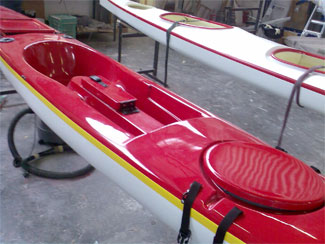
The Marlins deep seat and cockpit, waiting to have the rudder pedals fitted.
Having left the beach I tried a couple of braced turns, a method used to turn a kayak through 180 degrees with only 3 paddle strokes and a committed lean into the turn dropping the inside gunwale, she felt secure and effortlessly turned through a 180 degree arc.
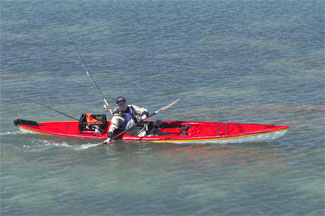
Leaning into a braced turn.
Paddling out towards Flag Rock (a large rock with a flag pole and flag) the Marlin was noticeably quiet, gliding smoothly over the wind blown chop out in the middle of the bay. The cross shore wind hardly effected the Marlin, although life was made much easier by lowering the standard fitted rudder. The rudder pulley system is the same as fitted to the Kaskazi Dorado, Pelican and the rest of their range. Lowering the rudder is done by pulling the rudder line toggle furthest aft firmly towards the bow, the system needs a clean tug to ensure that it lowers easily, the system is not as easy to use as those made by other manufacturers. Raising is much easier. Playing around with the position of the toggles may be enough to aid the smooth deployment of the rudder.
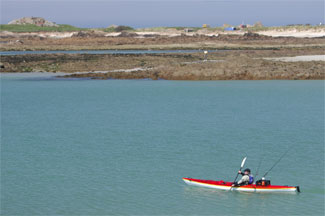
Heading out to Flag Rock.
With the rudder lowered I was pleased to find that the toggles were clear of my paddle stroke as this had been a niggle when paddling the Pelican. The actual position of the toggles can be altered to suit the individual paddler. Keeping on course with a following swell was simply a case of rocking a foot pedal forward, the kayak adjusts its course quickly and efficiently. Should you forget that you have the rudder deployed when paddling in shallow water, the rudder will simply kick up reducing any likelihood of damage.
With a change of direction I heading into the wind. With the rudder in the raised position there is less drag and the Marlin's 'easy to paddle' efficient design made a normally tiring course less of an ordeal. The buoyancy in the bow helps the bow glide over any swell, making for a dryer ride, the Marlin really is a lovely paddle.
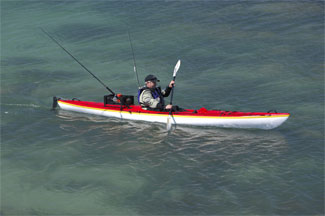
Heading back to the beach.
As a kayak for fishing, the Marlin has several standard fittings to make your day afloat more enjoyable. Behind the cockpit are a pair of flush mounted rod holders with thoughtfully positioned pad eyes to enable rod leashes to be fitted. A convenient small bait box/tackle box is fitted to the centre console providing access to small items of tackle without the need to reach around into the crate which is fitted over the rear hatch recess.


The Marlin's small bait/tackle box built into the centre console.
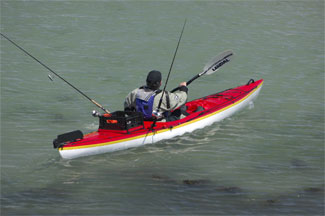
Flush mount rod holders and crate come as standard fittings.
Anchoring is made easy with three anchor trolley systems provided as standard, one on each bow gunwale and one to the stern port gunwale, and finally one of those nice touches, a bungee paddle keep stretched across the bow, somewhere to stow your paddle safely and quickly should you spot a bait bust and need to grab a rod in a hurry.
The Marlin is a great kayak designed for those that like to fish light, don't carry loads of tackle and enjoy their paddling, including camping and touring. If you have a need to carry loads of gear and seek to pursue really large fish, then take a look at the Kaskazi Dorado.
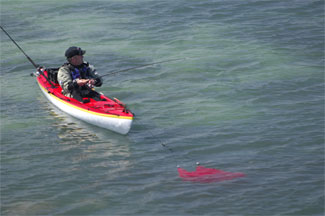
Time to try the Kaskazi Drogue and do a little fishing.
